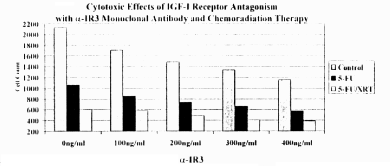Abstracts
1998 Digestive Disease Week
#1072
GROWTH FACTOR RECEPTOR ANTAGONISM RESULTS IN ENHANCED RESPONSE TO CHEMORADIATION THERAPY IN COLON CANCER CELLS. A Shurin, E Perer, Y Pang, K Romaguera*, E Zakris*, DJ Beech. Tulane University School of Medicine, Department of Surgery, Section of Radiation Oncology*, New Orleans, LA.
Colorectal cancer remains one of the most prevalent malignancies in the United States with approximately 155,000 new diagnoses and 55,000 deaths annually. Significant improvement in local disease control is seen when 5-Fluorouracil (5-FU) is used in combination with pelvic irradiation for rectal adenocarcinoma. Due to the frequent overexpression of Insulin-like Growth Factor I receptor (IGF-I-R) in rectal adenocarcinoma, inhibition of the signal transduction pathway through receptor antagonism may be a novel approach to enhance tumor response. This investigation seeks to define the role of IGF-I-R antagonism, using monoclonal antibody (_-IR3), in augmenting cytotoxicity to adjuvant chemoradiation therapy for adenocarcinoma of the rectum. Methods: After initial attachment of the plated 2000 cells per well, SW 480 colon cancer cells were cultured to semiconfluent conditions in DMEM and 2.5% fetal bovine serum. Initially, dose titrations were performed for 5-FU to determine that the IC50 (inhibitory concentration for 50% of the cells) was 0.5 µg/ml. Then IC50 was reassessed in the presence of IGF-I. Experimental groups were: 1) SW 480 cells + 5-FU (0.5 µg/ml) + _-IR-3 antibody; 2) SW 480 cells + 6 MeV external beam radiation (100 - 500 cGy) + _-IR-3 antibody; and 3) SW 480 cells + 5-FU (0.5 µg/ml) + 6 MeV external beam radiation (100 - 500 cGy) + _-IR-3. Following a 24-hour incubation at 37° C, viability assays were performed along with cell quantitation. Results: The addition of 100 ng/ml IGF-I one hour prior to 5-FU or radiation significantly blunted the expected cytotoxicity resulting in a 10-fold increase in the IC50 (from 0.5 µg/ml to 5 µg/ml). Receptor antagonism using the monoclonal antibody, _-IR-3 (100 ng/ml - 400 ng/ml) produced a dose-dependent increase in cytotoxicity compared to 5-FU alone. The addition of radiation produced synergistic amplification of this response.

Conclusion: IGF-I receptor activation blocks the expected cytotoxic effects of 5-FU and external beam radiation. Receptor antagonism increased the cytotoxic response of chemoradiation therapy. These data suggest the utility of inhibiting IGF-I receptor signal transduction in the treatment of rectal adenocarcinoma.
Copyright 1996 - 1998, SSAT, Inc. Revised 29 June 1998.
|
 500 Cummings Center
500 Cummings Center +1 978-927-8330
+1 978-927-8330
 +1 978-524-0461
+1 978-524-0461